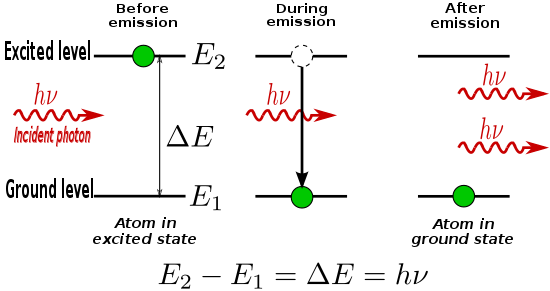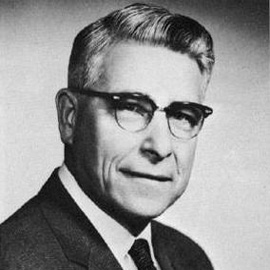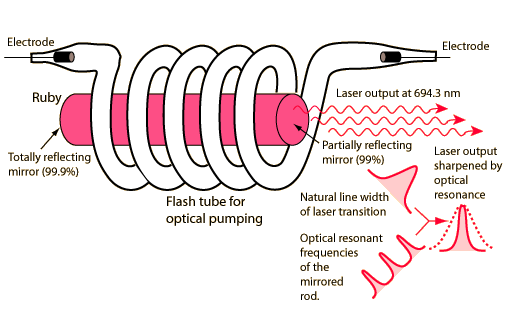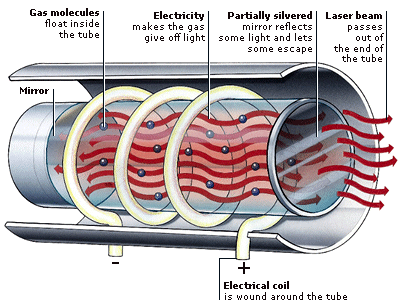 In 1953, Charles Hard Townes and graduate students James P. Gordon and Herbert J. Zeiger produced the first microwave amplifier, a device operating on similar principles to the laser, but amplifying microwave radiation rather than infrared or visible radiation. Townes's maser was incapable of continuous output.
In 1953, Charles Hard Townes and graduate students James P. Gordon and Herbert J. Zeiger produced the first microwave amplifier, a device operating on similar principles to the laser, but amplifying microwave radiation rather than infrared or visible radiation. Townes's maser was incapable of continuous output.In 1957, Charles Hard Townes and Arthur Leonard Schawlow, then at Bell Labs, began a serious study of the infrared laser. As ideas developed, they abandoned infrared radiation to instead concentrate upon visible light. The concept originally was called an "optical maser".
Simultaneously, at Columbia University, graduate student Gordon Gould was working on a doctoral thesis about the energy levels of excited thallium. When Gould and Townes met, they spoke of radiation emission, as a general subject; afterwards, in November 1957, Gould noted his ideas for a “laser”, including using an open resonator (later an essential laser-device component).
At a conference in 1959, Gordon Gould published the term LASER in the paper The LASER, Light Amplification by Stimulated Emission of Radiation. Gould’s linguistic intention was using the “-aser” word particle as a suffix – to accurately denote the spectrum of the light emitted by the LASER device; thus x-rays: xaser, ultraviolet: uvaser, et cetera; none established itself as a discrete term, although “raser” was briefly popular for denoting radio-frequency-emitting devices.
Gould’s notes included possible applications for a laser, such as spectrometry, interferometry, radar, and nuclear fusion. He continued developing the idea, and filed a patent application in April 1959. The U.S. Patent Office denied his application, and awarded a patent to Bell Labs, in 1960. That provoked a twenty-eight-year lawsuit, featuring scientific prestige and money as the stakes. Gould won his first minor patent in 1977, yet it was not until 1987 that he won the first significant patent lawsuit victory, when a Federal judge ordered the U.S. Patent Office to issue patents to Gould for the optically pumped and the gas discharge laser devices. The question of just how to assign credit for inventing the laser remains unresolved by historians.
On May 16, 1960, Theodore Maiman invented the ruby laser considered to be the first successful optical or light laser. Many historians claim that Theodore Maiman invented the first optical laser, however, there is some controversy that Gordon Gould was the first.
The first gas laser (helium neon) was invented by Ali Javan in 1960. The gas laser was the first continuous-light laser and the first to operate "on the principle of converting electrical energy to a laser light output." It has been used in many practical applications. In 1962, Robert Hall created a revolutionary type of laser that is still used in many of the electronic appliances and communications systems that we use every day.
The carbon dioxide laser was invented by Kumar Patel in 1964. Hildreth Walker invented laser telemetry and targeting systems.
Doctor Steven Trokel patented the Excimer laser for vision correction. The Excimer laser was originally used for etching silicone computer chips in the 1970s. Working in the IBM research laboratories in 1982, Rangaswamy Srinivasin, James Wynne, and Samuel Blum saw the potential of the Excimer laser in interacting with biological tissue. Srinivasin and the IBM team realized that you could remove tissue with a laser without causing any heat damage to the neighboring material.
New York City ophthalmologist, Steven Trokel made the connection to the cornea and performed the first laser surgery on a patient's eyes in 1987. The next ten years were spent perfecting the equipment and the techniques used in laser eye surgery. In 1996, the first Excimer laser for ophthalmic refractive use was approved in the United States.
Lately lasers have been in the news for good and bad reasons, despite the history and patent ownership lasers have a grow number of functions. They serve as surgical tools for treatment of delicate organs and cancer. They have great potential for communications, one recent idea is to incorporate quantum entanglement for instantaneous and encrypted communications. The exciting development of increasing the power output of a laser has open applications for the military not for targeting but also as a weapon on drones, missile defense and bomb disposal. There is also the possible prospect of triggering and maintaining a nuclear fusion via laser which is on the cusp of becoming a reality.
As well as the latest developments for nuclear fusion, the latest "big science" experiment being proposed by physicists will see the world's most powerful laser being constructed. Capable of producing a beam of light so intense that it would be equivalent to the power received by the Earth from the sun focused onto a speck smaller than a tip of a pin, scientists claim it could allow them boil the very fabric of space – the vacuum. Contrary to popular belief, a vacuum is not devoid of material but in fact fizzles with tiny mysterious particles that pop in and out of existence, but at speeds so fast that no one has been able to prove they exist. The Extreme Light Infrastructure Ultra-High Field Facility would produce a laser so intense that scientists say it would allow them to reveal these particles for the first time by pulling this vacuum "fabric" apart. They also believe it could even allow them to prove whether extra-dimensions exist.
 Its hard to predict if the fourth laser in Europe's Extreme Light Infrastructure project (or ELI) measuring 200 petawatts, will do as many people are claiming. If it can make exotic particles from a vacuum, perhaps it can compete with the Large Hadron collider and explain more about nature. I wouldn't want to speculate the far fetched claims about creating mini black-holes or a continued source of antimatter. Not matter what the future lays with lasers, it seems we still finding more uses and that there might be no limits of what we can burn given the right laser...
Its hard to predict if the fourth laser in Europe's Extreme Light Infrastructure project (or ELI) measuring 200 petawatts, will do as many people are claiming. If it can make exotic particles from a vacuum, perhaps it can compete with the Large Hadron collider and explain more about nature. I wouldn't want to speculate the far fetched claims about creating mini black-holes or a continued source of antimatter. Not matter what the future lays with lasers, it seems we still finding more uses and that there might be no limits of what we can burn given the right laser...




No comments:
Post a Comment